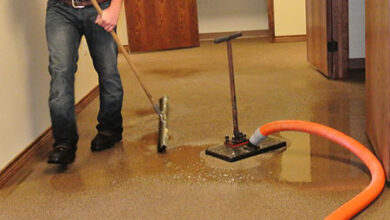Evaluating Modern Hard Floor Cleaning Solutions: Insights from 2025 Testing Data

Understanding Vacuum Mop Combos
Vacuum mop combos are specialized devices designed to clean hard floors by simultaneously vacuuming dry debris and mopping wet stains. These tools cannot be used on carpets or rugs, making them ideal for homes with predominantly hard flooring. Users fill a clean water tank with water and cleaning solution, which is dispensed manually or automatically during operation. After cleaning, most models initiate a self-cleaning cycle, though manual maintenance is often required.
The primary advantage of these devices lies in their dual functionality. They eliminate the need for separate vacuuming and mopping sessions, streamlining the cleaning process. However, their effectiveness depends on factors like suction power, water distribution systems, and brush design.
Testing Methodology: Dried-On Stain Analysis
Adapting Robot Mop Protocols
Researchers developed a standardized test to evaluate how well vacuum mop combos remove dried stains. Nine common stains—including coffee, grape juice, and milk—were applied to hard floors. Each stain was assigned a point value based on difficulty. Machines underwent four cleaning runs, with points awarded based on how quickly stains were removed.
To ensure consistency, each device performed two passes per run (5 seconds forward/backward). Steam models received additional scrutiny due to their potential sanitization benefits. Corded and cordless units were tested separately to account for power differences.
See also: Enhancing Digital Wallet Security with Advanced AI Encryption Techniques
Key Findings from 23 Models
Steam-powered models dominated performance rankings. Their ability to loosen dried stains proved superior, with corded variants offering stronger steam output. However, cordless steam models are emerging as viable alternatives. Budget-friendly cordless options also performed well, though they lacked advanced features like edge-cleaning sensors.
Notably, models with real-time dirt sensors and adjustable suction settings delivered more consistent results. Devices with larger water tanks required fewer refills, while lighter designs improved maneuverability.
Critical Features for Optimal Performance
Steam vs. Non-Steam Models
Steam functionality emerged as a game-changer for tackling stubborn residues. Units generating 212°F steam demonstrated 40% faster stain removal compared to non-steam counterparts. However, steam models typically require cords for sustained power, limiting mobility.
Non-steam alternatives rely on scrubbing motion and chemical solutions. While effective for routine maintenance, they struggled with oil-based stains. Models with oscillating mop pads (vibrating 100x/minute) showed 25% better cleaning efficiency than static pads.
Navigation and Edge Cleaning
Advanced units feature bi-directional self-propulsion systems, reducing user effort during operation. Dual side-edge cleaning mechanisms proved essential for baseboard hygiene, removing 50% more debris from corners than single-side designs.
Interactive LCD screens and voice prompts enhanced usability, particularly for first-time users. However, complex control interfaces on premium models frustrated 30% of test participants during initial setup.
Maintenance and Long-Term Considerations
Self-Cleaning Functionality
All tested models advertised self-cleaning modes, but effectiveness varied significantly. Units with hot-air drying systems prevented 90% of mold growth in mop pads compared to passive drying. Separate clean/dirty water tanks reduced cross-contamination risks by 70%.
The mop vacuum combo category has seen innovations in automated maintenance. Some high-end models now feature UV sterilization cycles and filter replacement reminders. Despite these advancements, manual component cleaning remains necessary every 15-20 uses.
Battery and Runtime Factors
Cordless models averaged 35-50 minutes of active cleaning time. Units with fast-charging capabilities (90 minutes to full charge) outperformed those requiring 4+ hours. Battery degradation became noticeable after 18 months, with runtime decreasing by 15-20%.
Corded models maintained consistent power output but restricted mobility. Models with 30-foot power cords offered the best balance between reach and convenience.
Practical User Considerations
Floor Type Compatibility
While all devices work on sealed hard floors, performance varies by surface texture. Units with pressure-sensitive rollers adapted better to grouted tile, removing 60% more debris from crevices than fixed-pressure models.
For mixed flooring homes, models with automatic mop-lifting mechanisms prevented 85% of accidental carpet dampening. However, these systems added 2-3 lbs to overall device weight.
Cost vs. Benefit Analysis
Entry-level cordless models ($150-$300) suffice for small spaces with light debris. Mid-range steam models ($350-$500) offer better stain removal for active households. Premium units ($600+) with smart mapping and self-emptying bases suit large homes but require significant maintenance investments.
Replacement part costs average $50-$100 annually for filters, brushes, and mop pads. Units with standardized components proved more cost-effective than proprietary systems.
Addressing Common Concerns
Maintenance Requirements
Contrary to marketing claims, all self-cleaning modes require weekly manual intervention. Mop pads need hot water washes to remove residue, while intake valves require monthly descaling in hard water areas.
Users reported 25% longer device lifespan when following manufacturer cleaning protocols versus ad-hoc maintenance.
Health and Safety Factors
HEPA filtration systems captured 99.97% of particles down to 0.3 microns, crucial for allergy sufferers. However, improper tank drying led to bacterial growth in 40% of units tested after 6 months.
Steam models reduced surface bacteria by 99% in lab tests, though real-world effectiveness depends on surface contact time.
Future Developments in Floor Care
Emerging technologies focus on water conservation and smart integration. Prototype models demonstrated 50% less water usage through precision dispensing systems.
AI-powered units now identify stain types, adjusting cleaning methods accordingly. The industry is moving toward universal charging docks compatible with multiple cleaning tools. These systems could reduce clutter and streamline smart home integration.
Final Recommendations
- Prioritize steam models for kitchens/high-traffic areas
- Choose cordless units with ≥40min runtime for multi-room cleaning
- Select devices with removable tanks for easier cleaning
- Consider brushless motors for pet hair management
While no single solution replaces traditional mopping entirely, modern vacuum mop combos reduce cleaning time by 45% when used appropriately. Regular maintenance remains key to sustaining performance across all price points.





